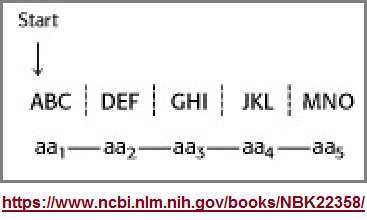~ 16 ~
~ The Study of Threes ~
http://threesology.org
Researchers as of 8/29/2019
| Devil's Advocate Series: | ||||||||
|---|---|---|---|---|---|---|---|---|
| 1 | 2 | 3 | 4 | 5 | 6 | 7 | 8 | 9 |
| 10 | 11 | 12 | 13 | 14A 14B |
15 | 16 | 17 | 18 |
| 19 | 20 | 21 | 22A 22B |
23 | 24 | 25 | 26 | 27 |
| 28 | 29 | 30 A | 30 B | 31 | 32 | 33a | 33b | 33c |
| 34 | 35 | 36 | 37 | 38 | 39 | 40 | 41 A | 41 B |
Since there are various different formulas of "threes" examples which can be culled from different subjects, one might be inclined to simply make a list of them and seek some unifying reason for their occurrence. If one is disposed towards interpreting everything through one or another veil of religion, no doubt a religious "reason" can be adopted. The same goes for those inclined towards a personalized other-worldly metaphysics, or biology, or psychology, or cultural anthropology, or mix and match as you will one subject or another. Beyond this simplification of attendance, one may then decide to include not only patterns-of-three, but other recurring patterns from different subjects as well, though often I encounter this effort is restricted towards compiling examples from everyday knowledge and not necessarily the materials to be found in a deeper study of some "serious" text or textbook. The types of examples reveal the orientation of the individual or group doing the compilation. While everyday occurrences of "threes" or other patterns may be of interest to the everyday observer of life's day-to-day narration as they encounter it in their respective world-view and cultural, economic, educational, gender, etc., setting, such examples will not suffice for those inclined towards a more detailed interest in one or another subject. Then again, the more specialized one gets in their collection(s), the more such a collection can become isolated from a larger audience whose interest in deeper subject matter may be limited to that which they are privy to in terms of available materials to be encountered in their own research interests.
Another effort is to catalogue not only various threes, but an absence thereof... as well as when they occur with other patterns, numbers or otherwise. Furthermore, one should be interested in compiling a list of examples which appear to provide a developmental sequence... if not of a given item, then the usage of the pattern(s) by a given individual or group in order to identify origin(s), simplicity/complexity, duration, and of course possible branchings through cultural adaptations suggestive of a biological matrix... even if this is but a metaphorical perspective of the activity actually taking place. The previously suggested timeline of three-patterned events occurring in biology is a differentiated exercise reminiscent of an adaptive branching activity in growth. Let me provide the image again for those who have come upon this singular page by having not followed the sequential route of pagination:
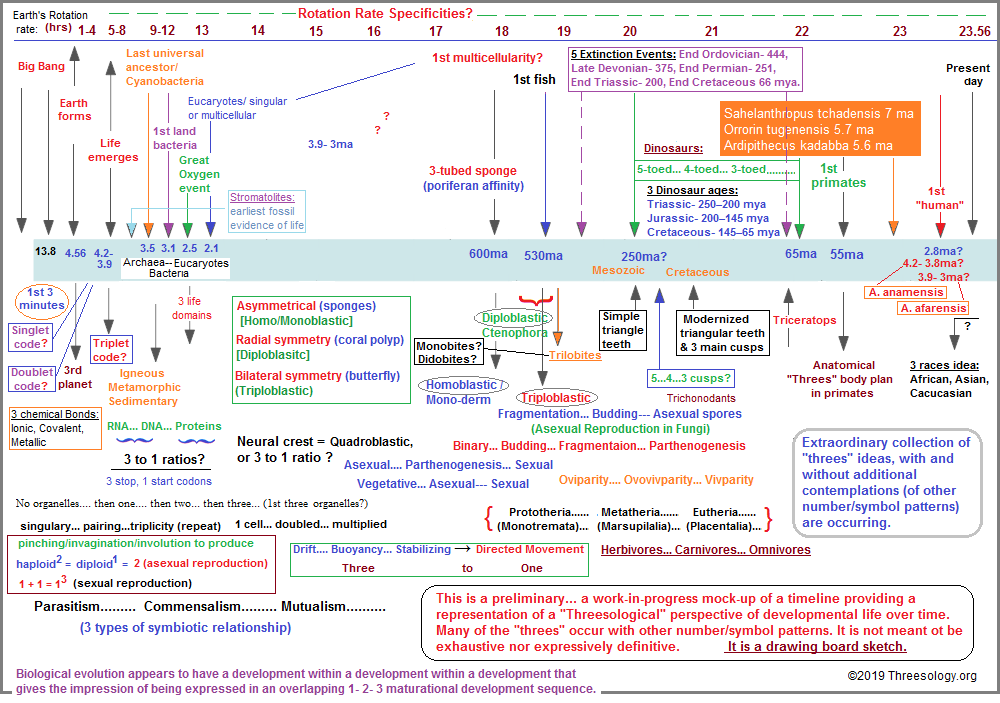
Even if one argues, as I sometimes do against that which I uncover; that threes are not the only pattern and it does not always occur alone, I am nonetheless compelled to compile the different patterns of threes being identified by different researchers, as if these patterns actually exist in that which is being studied and are not a mere artifact of a similar brain functionality occurring over time and in different places because of a human-shared alike physiology which inclines the species towards similar orientations... though variations do occur. Yes, I too see the many different occasions of non-three occurrences, but this does not defray from the course of development which patterns-of-three are none-the-less being exhibited in different, but inter-twined biological contexts related to an evolutionary process, of which the human mind is a part of.
While different perceptions can uncover different patterns, there is a regularity of a few patterns being recited over and over and over again. And these patterns all exhibit low quantity values. For example, as I have already mentioned that some people might focus on the triplet code pattern of DNA and RNA, other people may focus on the two-patterned models of twinned amino acids and the double helix. And yet another person may be inclined to take into consideration the relationship of both and alternative patterns as well, including that which muses in terms of the same developmental 1-2-3 trend as I am, concerning the placement of a triple helix development in the lineage:
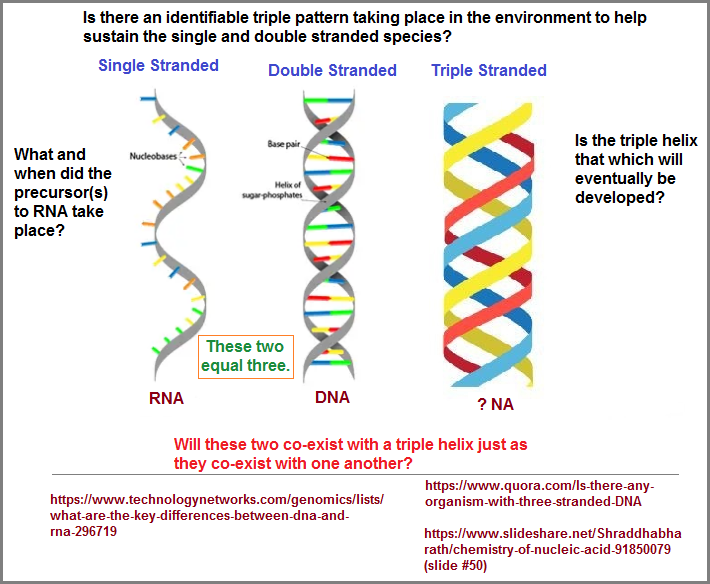
Despite this 1-2-3 developmental consideration, we must not overlook the fact that there is no large numerical values being used to represent either structure or functioning, even if one on occasion makes mention of the overall "64" amino acid quantity when thinking about how the triplet code idea was agreed upon because it served to address the issue of numerically accounting for the necessary 20 amino acids. It is rather hypocritical for humanity to have concerned itself with emphasizing the need for making a numerical account for the presence of 20 amino acids, thereby establishing the idea of a "3-based code", yet it does not emphasize putting forth the same effort for making an account of the recurrence of repeating numerical values associated with all of biology and that these same low value enumerations can be found in other subjects as well. A short review of the amino acids might be helpful for some at this point:
Twenty important amino acids are crucial for life as they contain peptides and proteins and are known to be the building blocks for all living things on earth. They are used for a protein synthesis. Amino Acids
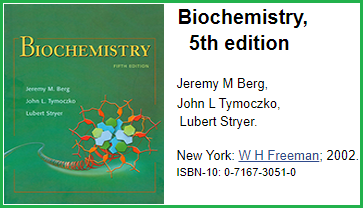
The genetic code is the relation between the sequence of bases in DNA (or its RNA transcripts) and the sequence of amino acids in proteins. Experiments by Francis Crick, Sydney Brenner, and others established the following features of the genetic code by 1961:
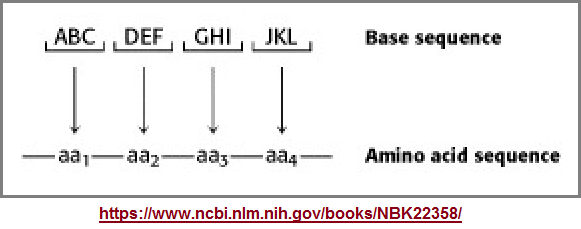
All 64 codons have been deciphered (Table 5.4). Because the code is highly degenerate, only tryptophan and methionine are encoded by just one triplet each. The other 18 amino acids are each encoded by two or more. Indeed, leucine, arginine, and serine are specified by six codons each. The number of codons for a particular amino acid correlates with its frequency of occurrence in proteins. 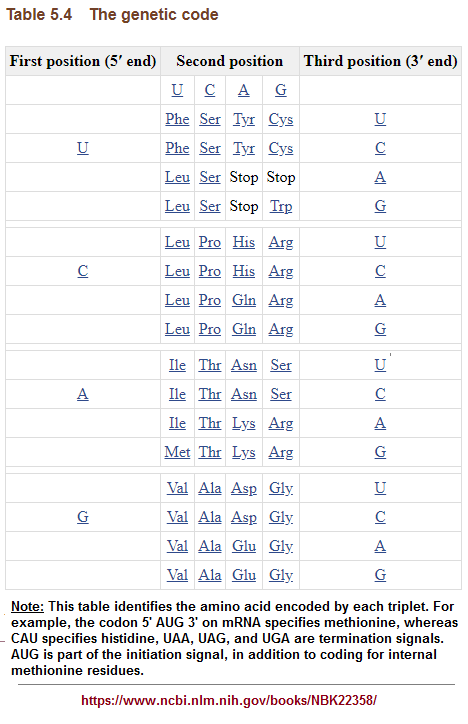 Amino Acids |
Thankfully, in the short expose' of a larger document, the author included a comment about the longevity of the Triple code:
Why has the code remained nearly invariant through billions of years of evolution, from bacteria to human beings? A mutation that altered the reading of mRNA would change the amino acid sequence of most, if not all, proteins synthesized by that particular organism. Many of these changes would undoubtedly be deleterious, and so there would be strong selection against a mutation with such pervasive consequences.
The question deserves an answer. It might be more accessible if we include the larger array of "threes" examples from different subjects and view it from multiple disciplines. At present, it might humorously be viewed as being synonymous with the Holy Grail... a biological Holy Grail.
However, despite the list of four underlined and Italicized distinctions, we could also add at least three others:
- The code is a low number whose value manifests itself in a variety of biological and non-biological forms and functions, perhaps suggesting both a genetic influence and an environmental influence.
- The so-called "triplet" code can also be interpreted to be a 3-to-1 ratio which can thus be associated with a larger array of biological and non-biological forms and functions. (For example, there are 3 stop codons and 1 start codon which is a 3-to-1-ratio.)
- The code may be an expression of a presently stable non-biological influence that may not be as stable (due to an unrecognized cyclicity?) as a billions-of-years-old code leads some to believe in as suggesting an immutability.
In addition, let us state the obvious by saying the code, as a recurring "triple" pattern, has not itself evolved. And as another example of a presently sighted three-"coded" biological character, the overall "three" of the Three Germ layers remains the same, though it developed along a seemingly recognizable 1-2-3 (Monoploblastic- Diploblastic- Triploblastic) route. Thus far, it is unchanging, unless one wants to pursue the argument that there is a 4th Germ Layer called the Neural Crest; whether or not it differentiated from one or more of the other three. Then again, such a "4-model" would necessarily be subjected to the scrutinization of those who are inclined towards thinking in terms of a 3-to-1 (or 1-to-3) ratio... (unless a "3-in-1", 1-from-3, 3-from-1, etc... definition is applied).
While we do see a triplet code, and the presence of multiple examples of 1-2-3 developmental occurrences have been identified, it stands to reason that we should consider there was a former two-patterned and one-patterned code... even if nothing was actually coded. The preliminary steps in the development of a triple code are nonetheless representative steps of a 1-2 sequencing event. If the triplet code came from not biologically specific chemistry, something in the environment or coincident with the chemistry itself had an influence that was so intense as to establish self-replication. Since we can see DNA having two strands and RNA having one strand... coupled to the idea that there existed an "RNA world" prior to a DNA world, the single-strand followed by a double-strand scenario is suggestive of a 1-2... developmental sequence which has not presumably "matured" into a triple-stranded creature. However, this may not be possible under certain environmental conditions prevail. The necessary conditions might be understood if we could understand the environmental conditions under which the single, then the double- strands occurred... and have been sustained. What occurred to tip the scales for the development of a double strand, and will such an occurrence take place to tip the scales in favor of a triple-strand development?
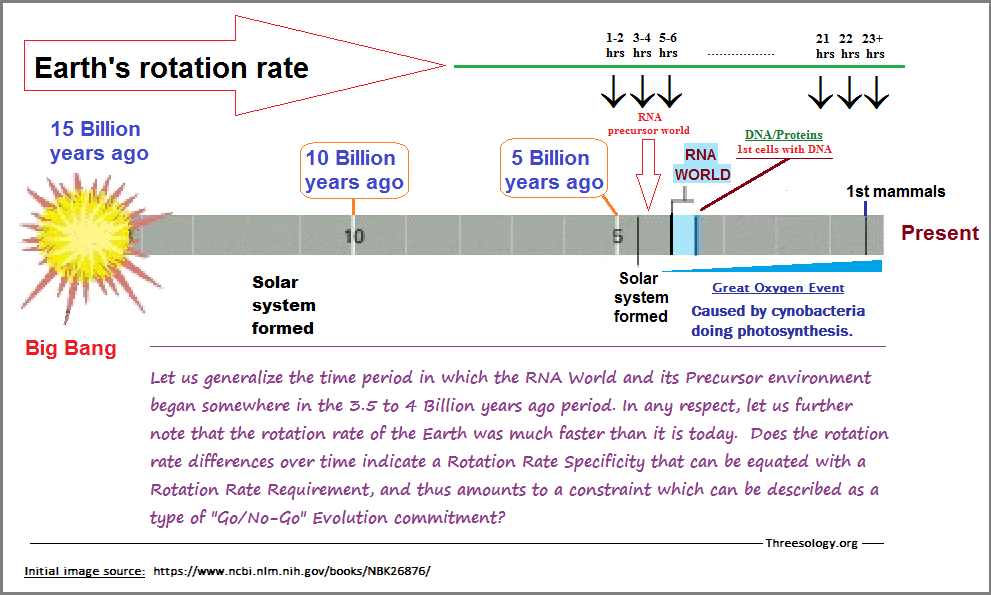
By recording the different models of enumeration that have and are taking place throughout biology and elsewhere, we might be provided with a "heads-up" to a change taking place... whether this is to be interpreted as a good thing or something unfavorable.
The existence of having 20 essential-to-life amino acids directed the attention of those seeking to elaborate their understanding of the underlying repetitions involved that were translated into an enumeration, instead of being left as a worded sentence or lettered alphabet. In other words, by applying the usage of numbers, a basic formula could be understood without the ambiquity which letters and words frequently provide interpretations. Although the usage of numbers is not perfect, it provides a means of reducing interpetations to a skeletal or blueprint level of illustration. I say "not perfect" because enumeration, and for that matter mathmatics, can often produce stick figures that are meant as skeletal frameworks, and therefore detract from needed details.
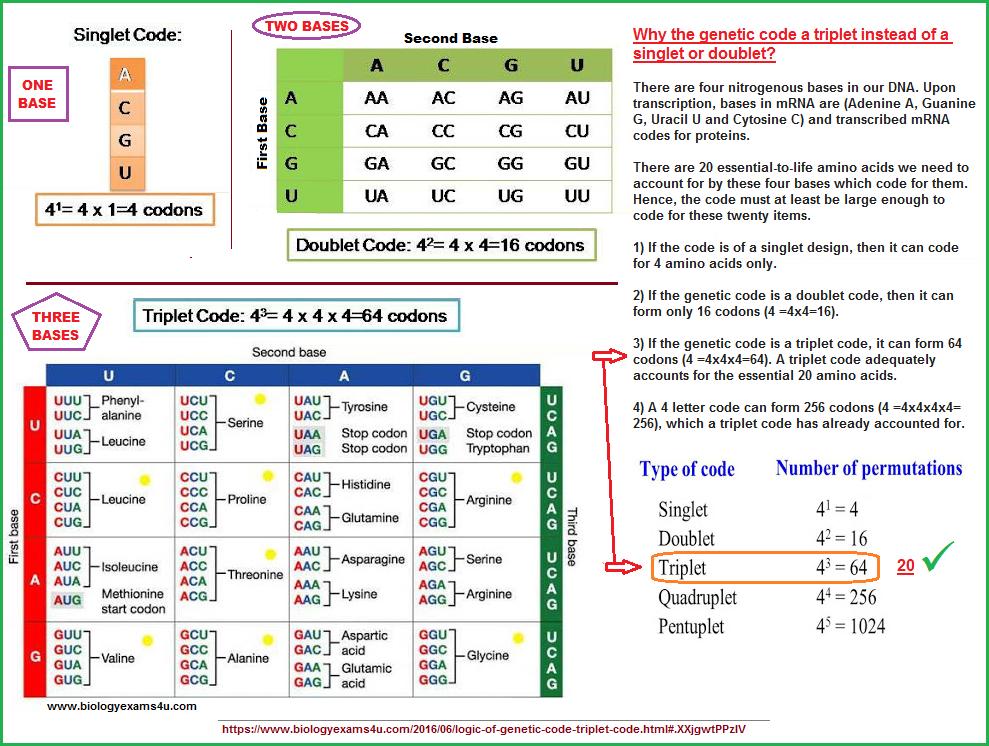
Let us take a gander at a view about the development of the Genetic Code, though I have made reference to it sometime before the present series of articles began:
The genetic code is nearly universal, and the arrangement of the codons in the standard codon table is highly non-random. The three main concepts on the origin and evolution of the code are:
These theories are not mutually exclusive and are also compatible with the frozen accident hypothesis, i.e., the notion that the standard code might have no special properties but was fixed simply because all extant life forms share a common ancestor, with subsequent changes to the code, mostly, precluded by the deleterious effect of codon reassignment. Mathematical analysis of the structure and possible evolutionary trajectories of the code shows that it is highly robust to translational misreading but there are numerous more robust codes, so the standard code potentially could evolve from a random code via a short sequence of codon series reassignments. Thus, much of the evolution that led to the standard code could be a combination of frozen accident with selection for error minimization although contributions from coevolution of the code with metabolic pathways and weak affinities between amino acids and nucleotide triplets cannot be ruled out. However, such scenarios for the code evolution are based on formal schemes whose relevance to the actual primordial evolution is uncertain. A real understanding of the code origin and evolution is likely to be attainable only in conjunction with a credible scenario for the evolution of the coding principle itself and the translation system. |
Here is another perspective in attempting to address the development of the triplet code. I shall only provide a short excerpt:
Huan-Lin Wu, Stefan Bagby, Jean M.H. van den Elsen Abstract Explaining the apparent non-random codon distribution and the nature and number of amino acids in the .standard. genetic code remains a challenge, despite the various hypotheses so far proposed. In this paper we propose a simple new hypothesis for code evolution involving a progression from singlet to doublet to triplet codons with a reading mechanism that moves three bases each step. We suggest that triplet codons gradually evolved from two types of ambiguous doublet codons, those in which the first two bases of each three-base window were read ('prefix' codons) and those in which the last two bases of each window were read ('suffix' codons). This hypothesis explains multiple features of the genetic code such as the origin of the pattern of four-fold degenerate and two-fold degenerate triplet codons, the origin of its error minimizing properties, and why there are only 20 amino acids. Previous Hypotheses for Genetic Code Evolution It is now four decades since the canonical genetic code was deciphered to show how 64 three-base codons encode 20 amino acids. Explaining the apparent non-random codon distribution and the nature and number of amino acids in the code remains a challenge. Various arguments have been put forth to explain these characteristics of the code:
The 'frozen accident' model (Crick 1968), where codon assignments are historical accidents that became fixed in the last common ancestor of all organisms, does not explain or predict the observed order of codons. The frozen accident model has been challenged by three hypotheses which are based on 'adaptive', 'historical', and 'chemical' arguments (Knight et al. 1999). The adaptive hypothesis suggests that the pattern of codon assignments is a reflection of adaptations that reduce errors caused by mutation or mistranslation (Ardell and Sella 2002; Freeland and Hurst 1998; Freeland et al. 2000, 2003; Haig and Hurst 1991; Woese 1965a, b). The historical or co-evolution hypothesis proposes that the canonical genetic code evolved from a primitive ancestral form very early in evolution. This primitive code comprised a small number of amino acids encoded by 64 highly degenerate codons. The gradual expansion of the code is reflected in the pattern of codon assignments. Recently introduced amino acids would have been incorporated in the code by usurping codons of amino acids from related biosynthetic pathways (Amirnovin 1997; Wong 1975). The chemical argument suggests that the assignment of certain codons was directly influenced by chemical interactions between RNA and amino acids. Because the mechanisms that allowed recent changes in the genetic code might be entirely different from those that generated the code initially, the problem arises that all stereochemical theories might have dealt only with the canonical code found in the last common ancestor (Freeland et al. 2000). Historical theories propose a stepwise evolution from a system in which any tRNA required recognition of one base to tRNAs with specificities for the first and second bases. This evolution would have allowed more amino acids to be distinguished, and at a later time, when the system's specificity had improved, tRNAs could evolve with specificity for all three bases (Yockey 2000). In the light of this theory we present a new hypothesis for the evolution of the genetic code to the current triplet code from a highly degenerate triplet code that was functional first as a singlet code and later as a doublet code, using two types of codons. This hypothesis accounts for the overall codon patterns in the canonical genetic code and the origin of its error-minimizing properties. In addition, it explains why there are 64 codons and only 20 amino acids. Hypothesis The Evolution of Triplet Codons from Singlet Codons via Two Types of Doublet Codons The historical or co-evolution theory suggests that the genetic code was once simpler, with fewer types of amino acids. With increasing organismal complexity came the necessity for more amino acids. A system in which amino acids were encoded by one nucleotide could have evolved towards a two-base codon system. At a later time, tRNAs could have evolved with specificity for three bases, allowing more amino acids to be distinguished. But could an organism have survived a genetic code expansion? A change from a pure doublet codon to a pure triplet codon system, for instance, would cause a frame-shift that not only affects the encoded amino acid sequence, but also drastically reduces the number of amino acids in resulting polypeptide chains. On the subject of codon expansion, Francis Crick (1968) wrote:
In the same paper, however, Crick suggests a possible change from two base to three base codons that would avoid violation of 'the Principle of Continuity':
The codon expansion hypothesis described below is developed from Crick's 1968 statement: We hypothesize that the current triplet genetic code originates from a highly degenerate triplet code that is operational as a singlet code in which the reading mechanism moves three bases per step but in which only the middle base of each codon specifies the encoded amino acid (Fig. 1). In the subsequent doublet code either the first two bases (as suggested by Crick) or the last two bases of each three are read. We label a generic doublet codon as x, with doublet codons in which the first two bases are read termed prefix codons (ω_) and those in which the last two bases are read termed suffix codons (_ω). As illustrated in Figure 1, a codon expansion from singlet to doublet codons leads to a division of the genetic code into two types of doublet codons, prefix codons and suffix codons. In the doublet-to-triplet codon expansion, prefix doublet codons (ω_) evolve to triplet codons in which the third base is read for the first time, and suffix doublet codons (_ω) evolve to triplet codons in which the first base is read for the first time. 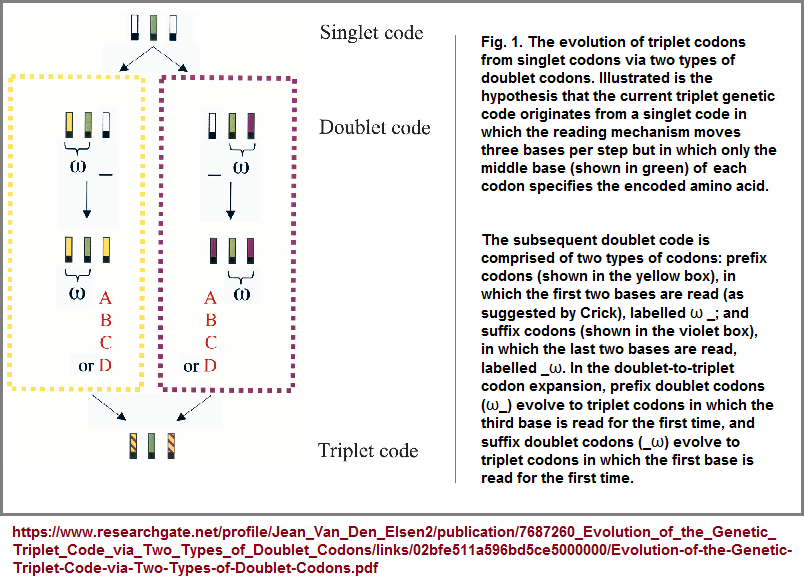 |
Here we have what appears to be another usage of a binary orientation like that seen in the zeroes and ones computations of computer code, the old yin/yang dichotomy, the dualities of philosophy and psychology, and other oppositional, stand-alone (side by side but not connected nor inter-acting), or complementary dualisms. Yet, as some have seen in the history of number development, there are starts and stops during transitional stages of thinking about quantity. For example, when the human began grasping the notion of the quantity of "one" coupled to some type of referential symbol, the path to thinking about a "two" quantity was a territory the human mind did not traverse into. After awhile this quantity became adopted by human thinking processes but was then the territorial boundary until the human mind traversed into the domain of thinking about three... which by some accounts was previously considered to be denoted as a land of many, much, or more. Hence, if if there were no distinct words for one, two and three, there nonetheless existed a pattern-of-three thinking in terms of quantifying with three words such as a person's own language equivalents for "one, two, many". If humanity is focused on using a "two", to the extent of being fixated on this quantity, then it may be a reflection of a primitive mindset that is once again playing out the old one-two-many theme in modern guises. There is nothing to prevent present day researchers or intellectuals from being mentally stuck in a two or two-transitioning-into-three mode of conceptualization.
And yet the primivity of biological processes may well exhibit such a primitive one-two.... three character in its makeup. The genetic code may well exhibit the same type of counting sequences we see having been used by primitive peoples that relied on mechanisms of singularity and doubling. Let us not forget that present day humanity expresses cognitive limit when it places a comma after every third number to mark higher divisions of numbers (thousands, million, etc...), not to mention exhibiting a limitation of thought by way of three punctuation marks known as periods, question marks, and exclamation points.
The foregoing suggest how the triplet code may have evolved once it got under way, but not what initiated the beginning process... whether chemical and/or otherwise, and what influenced the initiation, as well as what is sustaining it. Since we know that the triplet code (as far as we know) requires an Earth-like environment, and that the "Deox-" of the Deoxy-ribose indicates a less oxygen configuration; its activity suggests an encapsualization or envelopment (like a cellular environment inside a cellular environment perhaps in yet a third encasement). Because cells are closed systems... or perhaps one should say closed-off systems of interacting organelles, the Earth's environment can either be viewed as being favourable to the internal components or harmful to them (whereby they need to be insulated from it). In any event, if cellular activity is removed from the Earth's environment, they cease to exist and do not retreat to some form of hibernation to await a more favorable environmental condition... unless this is occurring on such a level in such a way that is presently undetectable. Yet, what is it, in terms of a specific three-patterned arrangement, which might account for a three-patterned influence? Unless the pattern-of-three is a cumulative effect of singularity or a singularity and doublet activity combined... but our brains are inclined towards emphasizing a holistic compartmentalization as a product of the process of an equilibrium adjustment to an overall deteriorating sun, moon, earth system.
A problem with the thinking about the triplet code solely in biological terms and contexts, is to overlook the possibility that the code itself may be the originator of other three-patterned "codes" found in different forms and functions of diverse biological events, including the many multiple "threes" ideas created by a biologically-based brain that are not attached to common biological nomenclatures. Indeed, in seeking a reason or influence for the many "three-patterned" ideas found in divergent contexts, one might well turn to the triplet code of DNA as the underlying progenitor. An additional issue to be brought forth that the usage of the word "triplet" tends to incline one to think in terms of a group effort, where in fact the triple pattern may be three singular step-wise(?) actions or 1 and 2-step wise activities. However, we then have to ask what initiated the development of the so-called triplet code with DNA and why is it sustained... whether or not it is solely due to chemistry interacting in the present state of environmental conditions. For example, does (or can) a triplet code arise wherever there is a third planet scenario like that of Earth, but not a second, first or forth... etc., planet? Is the third position "THE" singular influential condition?
There was once an old saying (back in the 1970s) that was expressed as "different strokes for different folks", which can be interpreted as a variation on the old theme of "live and let live", since they refer to providing allowances for behavior and ideas which are different from one's own customary orientations.
The phrase "live and let live" comes from the Dutch. It is found in the The Ancient Law-Merchant, a collection of commercial law compiled by G. De Malynes in 1622. This code of law was written by medieval merchants to govern trade throughout Europe, North Africa and Asia Minor. The first known instance of the phrase live and let live in English occurred in 1678, in A Compleat Collection of English Proverbs, by John Ray. The phrase live and let live is hyphenated when used as an adjective before a noun, as in live-and-let-live. (Live and Let Live)

|

|
This "different strokes for different folks" notion can be applied to the interpretation of the words "code, coding, codon". In other words, a three-patterned structure and/or process is a code inasmuch as a telephone number is, or daily exercise routine, or grocery list. We all may use different numbers, routines and lists, or interpret another's in a different way from them, but all of it is an environment of various types of codes. Whether one person sees a pattern-of-two, three, four, or whatever, the fact remains they are deciphering a form and or functionality with a code relative to their perception. If they can get everyone to agree with their perception, such an interpretation may well become established as a law, or generally accepted given. The idea of a triple code has achieved the standing of being viewed with a singular orientation, though this is not the case for other biological activities, as I have previously shown by exhibiting different interpretations of the same materials.
If all the evolutionary processes began on Earth, then let us further assume that this includes the usage of a Triplet code. Since the triple pattern can be observed in multiple other biological processes and anatomical forms as detected by our perceptions and mental processing, let us at least consider the possibility that some observable... or at least detectable three-patterned environmental event(s) influenced the pattern to not only occur, but be sustained. However, since the environment of Earth undergoes change, the influential pattern may also be subject to alteration, resulting in subsequent biological changes either good and/or bad. In order to understand when, how and why the triplet code emerged as a central theme in biological processes, we need to visually attempt to recreate early Earth conditions which involve the irradiation effects of the Sun coupled to an increased rotation rate of the Earth. A faster spinning Earth brings to mind not only the image of a laboratory centrifuge, but a strobe-light. As the Earth's rotation slows down, so do the "pulses" of the Sun's irradiation... through a single, then double (night/day) to a triple (dawn-noon-dusk), and onward towards a 3-into-1 scenario as the Earth slows down further and the Sun expands, whereby the 3 "moments" or phases of the Sun (dawn- noon- dusk) "fuse" together effecting a consolidation. 10:27 AM, 8/11/2019
Origination date: Tuesday, September 10th, 2019... 5:45 AM
Initial Posting: Wednesday, September 11th, 2019... 7:46 AM
Updated Posting:Tuesday, January 17th, 2023... 12:28 AM
Herb O. Buckland
herbobuckland@hotmail.com
